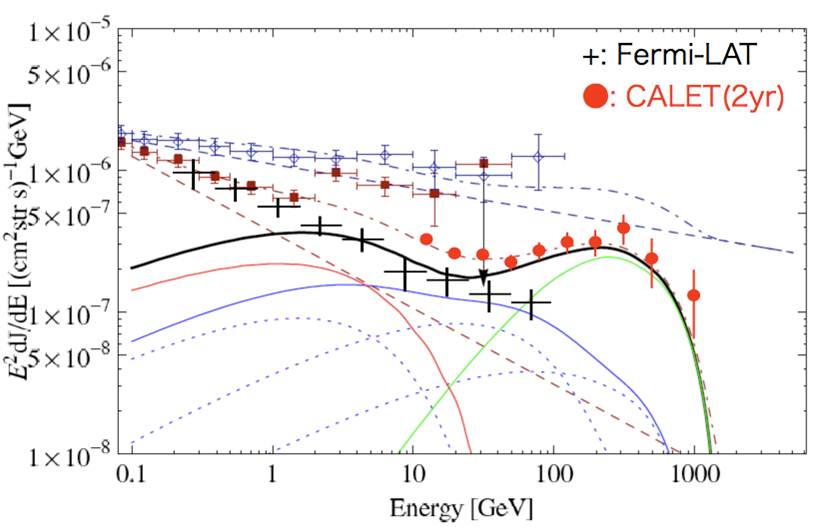High Energy Gamma Rays — CAL
“Search for GeV Gamma-ray Counterparts of Gravitational Wave Events by CALET”, O. Adriani et al., Astrophys. J. 863 (2018); https://doi.org/10.3847/1538-4357/aad18f .
“Characteristics and Performance of the Calorimetric Electron Telescope (CALET) Calorimeter for Gamma-Ray Observations”, N. Cannady et al., Astrophys. J. Suppl. 238:5 (2018); http://iopscience.iop.org/article/10.3847/1538-4365/aad6a3/pdf.
Diffuse Gamma Rays
CALET, of necessity, will measure the diffuse gamma ray background and can make an important contribution by extending the Fermi gamma ray observations to energies above ~100 GeV. An example of what CALET can accomplish is illustrated in Figure 1 which shows diffuse gamma ray results from EGRET (top) and Fermi compared to a particular model. The projected CALET results are indicated in red and demonstrate that CALET will be able to extend the Fermi data.

Figure 1. Diffuse gamma ray results anticipated for CALET compared
to previous data and to model predictions. Here the flux is multiplied by E2.
Ibarra, Tran and Weniger (2010) analyze the possibility of detecting gamma ray anisotropies with Fermi in a model that invokes an unstable (albeit long-lived) dark matter particle (T ~2 x 1026 sec) with large rest mass (up to 2.5 TeV) which can decay via multiple channels, e.g. direct production of gamma rays or production of e+e– pairs which then generate gamma rays via inverse Compton interactions. These different channels are represented by the different curves on the lower left of Figure 1 and are, in the main, well below the standard background. However, above ~100 GeV the “excess” gamma rays from this scenario become observable above the background. As can be seen, CALET should be able to detect or refute such a model for decaying dark matter.
It should be noted that there are currently very many models for both annihilating and decaying dark matter particles. Each model must be analyzed for its prediction of electron spectrum or gamma ray enhancements, and these predictions must then be compared to the CALET capabilities to determine what might be observed and/or what type of limit the CALET data could impose on the model, assuming existing data have not already done so. This is an on-going process that will continue through CALET launch and data analysis — especially considering the rate at which new theoretical models are produced. Yet again, this attests to the astrophysical promise for the CALET mission.
Low Energy Gamma Rays — CGBM
CALET/GCN home page
Table of CGBM light curves and GCN Notices
“CALET Search for Electromagnetic Counterparts of Gravitational Wave Events During the LIGO/Virgo O3 Run”, O. Adriani et al., Astrophys. J. 933, 85 (2022); https://doi.org/10.3847/1538-4357/ac6f53 .
“Detection of the Thermal Component in GRB 160107A“, Y. Kawakubo et al., Publ. Astronom. Soc. Japan 70, 6 (2018); https://doi.org/10.1093/ pasj/psx152
“Multi-Messenger Observations of a Binary Neutron Star Merger”, B.P. Abbott et al. (LIGO Scientific Collaboration, VIRGO Collaboration, and Partner Astronomy Groups), Astrophys. J. Lett. 848:L12 (2017); https://doi.org/10.3847/2041-8213/aa91c9.
“CALET Upper Limits on X-Ray and Gamma-Ray Counterparts of GW 151226”, O. Adriani et al., Astrophys. J. Lett., 829:L20 (2016); http://iopscience.iop.org/article/10.3847/2041-8205/829/1/L20/meta.